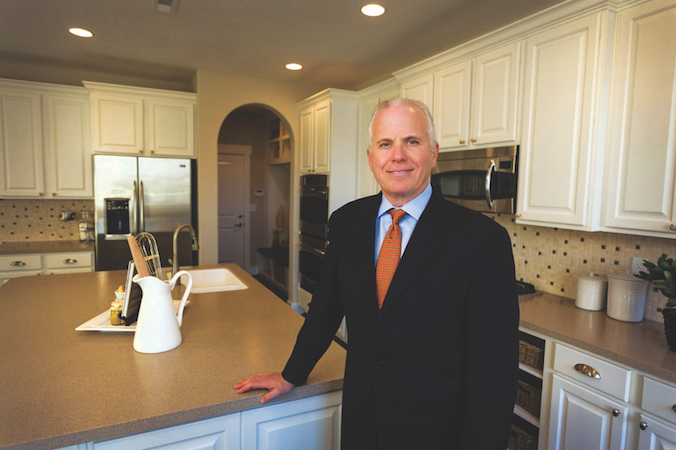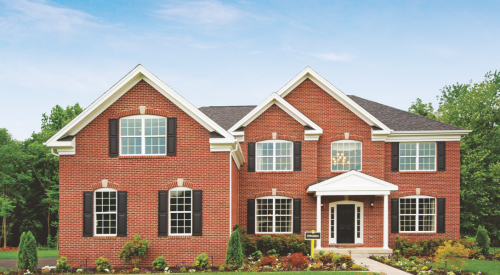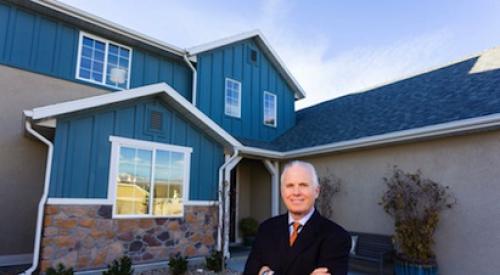In 2005, Woodside Homes closed nearly 3,700 houses and generated revenue in excess of $1.4 billion, becoming one of the largest private builders in the United States. Three years later, the company defaulted on more than $730 million in debt after the housing bubble burst and, as a result, filed for Chapter 11 bankruptcy.
Joel Shine, who agreed in 2009 to advise Woodside’s creditors committee and forestall the company’s liquidation, brought plenty of pertinent experience with him. A third-generation home builder, Shine had run the gamut of the industry, from managing and leasing a portfolio of properties to overseeing the development of thousands of residential units. But perhaps most importantly, Shine had spent the prior decade handling investment funds that focused on home building.
“One of the real advantages that I was given was I had been an equity provider to some of the larger public and private home builders around the country, so I had a chance to see what really worked and what didn’t work,” he says.
Woodside overleveraged its land positions during the housing boom and suffered crushing losses when the market floundered. “Home builders were putting current pay debt, and a lot of it, on dirt,” Shine recalls. “The leverage ratios and the terms that were applied to land loans just didn’t make sense.”
North Salt Lake, Utah-based Woodside, like many of its industry counterparts, was effectively broke. Shine’s directive as consultant included determining which areas of the company warranted restructuring, and which should remain intact despite the builder’s financial troubles. Shortly after starting his new gig, Shine discovered Woodside’s previous management had done an admirable job keeping the company lean and employing dedicated professionals who took pride in building a quality brand.
In fact, Woodside sold about 2,500 homes and captured market share while the company reorganized for 14 months. When the builder emerged from bankruptcy in 2010, Shine took the reins as CEO and tasked the independent board that he chairs with developing a long-term strategy for shareholders and employees. The senior management team opted to downsize, meaning Woodside would become a regional builder. A new corporate mantra was crafted to encapsulate the company’s focus on being robust yet nimble: “Look public, act private, make money.”
Woodside made a concerted effort to keep its financial problems separate from its home building operations. General Counsel Wayne Farnsworth managed the bankruptcy and worked with Chief Financial Officer Rick Robideau to ensure the company’s restructuring did not conflict with the builder’s primary function to construct quality houses and take care of its customers. Executives even asked Woodside employees for a special concession. “We never thought of it as a bankruptcy,” Shine says. “We sort of requested that everybody in the company take that term out of their lexicon.”
Shine, who had presided over two other corporate “turnarounds” before Woodside, learned while growing up in a family-run home building business that any one person can only do so many things particularly well. By breaking up responsibilities and allowing senior personnel to concentrate on specific tasks, the company expedited its restructuring as well as a comprehensive makeover of its product.
Tough decisions
Shine and his corporate team first had to determine how many divisions in which the company would operate and how large the builder would be geographically upon its re-launch. Before defaulting on its financial obligations, Woodside built homes in nine different states including Florida, Maryland, Minnesota, and Virginia. By the time he became CEO, Shine had walked every one of the builder’s 200 projects across the country, he says.
A brief history of Woodside Homes
1977Company founded in Utah1984Woodside becomes top Utah home builder1988Company enters the Las Vegas market1992Entry into the Phoenix market1997Woodside enters the Southern California market1998Entry into the Sacramento, Calif., market2000Division opens in California’s Central Valley and Woodside becomes the nation’s 46th largest builder with 1,786 closings2001Woodside closes 2,225 homes, becoming the 32nd largest builder2004Woodside acquires a Texas builder and enters the San Antonio market. Operations also begin in Fresno, Calif.2005Woodside closes 3,676 homes and becomes the 27th largest builder2008Woodside closes 2,072 homes and is the 20th largest builder2009Woodside closes 1,788 homes2010Woodside emerges from restructuring2010Woodside closes 1,444 homes and sells off East Coast assets to redeploy capital in the western divisions2011Woodside closes 888 homes2012Woodside recapitalizes with $75 million equity and $128 million debt from investors
Shine worked closely with key personnel to create a spreadsheet and grade each existing division based on 12 criteria. They considered the leadership qualities of current division presidents as well as the people immediately surrounding them. The company then judged each division’s land holdings and, in collaboration with John Burns and his staff at John Burns Real Estate Consulting, gauged the prospects of each specific housing market for the next few years.
Examining Washington, D.C., Shine and his team acknowledged their division president’s strong, capable leadership and agreed the area’s market outlook seemed favorable. But Woodside’s assets in Washington, D.C., left much to be desired—the company had just one attractive land holding amid a slew of top-of-the-market acquisitions that lost their value once housing crashed.
Shine concluded rebuilding the relatively small Washington, D.C., division and its balance sheet would prove more difficult than what it was worth; furthermore, the region presented logistical hurdles being so far away from the builder’s Salt Lake City headquarters. Woodside’s senior management decided to shutter the division and, after careful consideration of the builder’s other locations, moved to sell all of the company’s assets east of San Antonio. The resulting capital was redeployed to the remaining western divisions.
Woodside now builds homes in just five states—Arizona, California, Nevada, Texas, and Utah. Shine refers to the number of jobs being created relative to the amount of homes being built as a measure for assessing the strength of a particular market; a healthy one generally reflects a 1.1 or 1.2 ratio of jobs to homes, he says. Housing in the western U.S. generally fell furthest during the downturn and, as a result, markets such as Phoenix exhibit the greatest imbalances between supply and demand.
By retrenching west of San Antonio, Woodside positioned itself to take advantage of the hottest markets during the housing recovery. “Every market that we are in right now has a minimum of a 2-to-1 jobs-to-permit ratio; so they’re creating twice as many jobs as we are building houses,” Shine says.
The company is outperforming the market in many of its communities including Andalusia in Summerlin, Nev.; Countryside in Yuba County, Calif.; Bella Brisas in Sacramento, Calif.; Lindsay Park in Mesa, Ariz.; and Arrowood in San Antonio. Woodside’s Belvista community in Temecula, Calif., is the top-selling attached new-home development in the Inland Empire. In Utah, Woodside’s Foxboro community is one of the largest master-planned developments in the state. The builder’s redesign of Foxboro tripled the community’s sales pace and sparked rejuvenation.
Woodside remains committed to designing and building innovative single-family and multifamily homes targeted to entry-level and move-up buyers. The company’s lean overhead inspired a new design approach that focuses on personalization without sacrificing price or value.
Better by design

In order to reinvent Woodside, Shine knew the builder would have to accelerate sales and increase its footprint in the western U.S. markets. He tabbed Jay Moss, who had served as a regional president with KB Home for 25 years, as chief marketing officer and charged him with reshaping Woodside’s sales team and revitalizing the company’s product.
Moss started KB Home’s Las Vegas division from scratch and built up infrastructure predicated on process, people, and product. He repeated the task in 2000 when KB shipped him to Southern California to shore up the builder’s operations in the region. Not long after arriving at Woodside and evaluating the landscape, Moss found the company’s divisions were managed well but that its sales team never underwent serious training.
“I wanted the best sales force in the business because that’s what I thought it would take to turn it around,” says Moss, who understood Woodside’s salespeople were still a bit shell-shocked from the housing crash and the builder’s subsequent bankruptcy.
He contracted a professional coach to conduct intense training sessions and hone the company’s sales approach. Moss was careful not to include marketing concepts in the instruction because he wanted Woodside’s sales team focused on improving communication with prospective home buyers, an important consideration in light of the builder’s publicized bankruptcy.
With sales training underway, Moss turned his attention to the company’s product, which he admits was a bit outdated. Woodside’s homes for the most part did not embrace an open floor plan, a growing preference among current home buyers. The company’s product used arches to increase openness, but that architectural feature largely went out of style, Moss says. Woodside’s houses relied on a formal look replete with large interiors and bulky furniture, which clashed with the much more casual living environments sought-after in the current market.

For Woodside’s new product, Moss considered the kitchen and greater room as the command center of the home and incorporated aspects that appealed to generational housing and families facing the possibility of boomerang children. He worked with consultants such as John Burns and referenced consumer research to build a profile of current home buyers; consequently, Woodside began distributing an initial survey that placed prospective customers into one of three categories: traditional, contemporary, or eclectic.
“We weren’t just selling exteriors, we were selling interiors based on people’s taste,” says Moss, who spearheaded a new company initiative, “Better by Design,” which aims to deliver an exceptional home buying experience to every customer by allowing complete personalization and simplifying decision-making.
Instead of dragging prospective buyers to a cavernous, overwhelming design center, Woodside allows them to construct an “inspiration wall” in the sales office based on their personal tastes. Customers can choose from hundreds of different looks and combinations arranged by professional decorators—a thoughtful way to compete with resales.
Moss figured “Better by Design” would thrive in the entry-level market but was surprised to find the program resonated with third-time move-up buyers in Phoenix. Shine lauds the company’s creative new approach to home design and concedes the initiative took time to refine. “It’s the part of the company that we completely turned upside down,” he says. “And the feedback we’ve gotten directly from the buyers is that we’re right.”

Looking forward
On October 22, 2012, Woodside recapitalized with $75 million in equity and $128 million in notes that refinanced its existing debt. The recapitalization significantly increased the company’s liquidity, strengthened its balance sheet, and created the right financial structure to facilitate the builder’s aggressive growth plans.
Woodside reported $313 million in new residential construction revenue and 1,300 closings in 2012, up 45.1 percent from $215.6 million and 888 closings in 2011. When asked whether the private builder will follow the lead of Taylor Morrison and others and eventually sell stock to shareholders on a public exchange, Shine says delineations of public and private often miss the point: It all depends on how a company is capitalized. For now, Woodside does not need to raise money through an initial public offering, he adds.
“We’re probably a lot closer to being ready to go public in terms of reporting and good, sound finance and accounting management than most of the companies that are going public,” he says.
Woodside reduced its staff from about 800 employees during the builder’s peak to approximately 200 after the company’s restructuring, and Shine praises all of them for their contributions and sacrifices in saving one of the nation’s most successful home builders.
“At the end of the day, the letterhead doesn’t mean anything,” he says. “It’s a bunch of people working together." PB
PB Topical Ref













